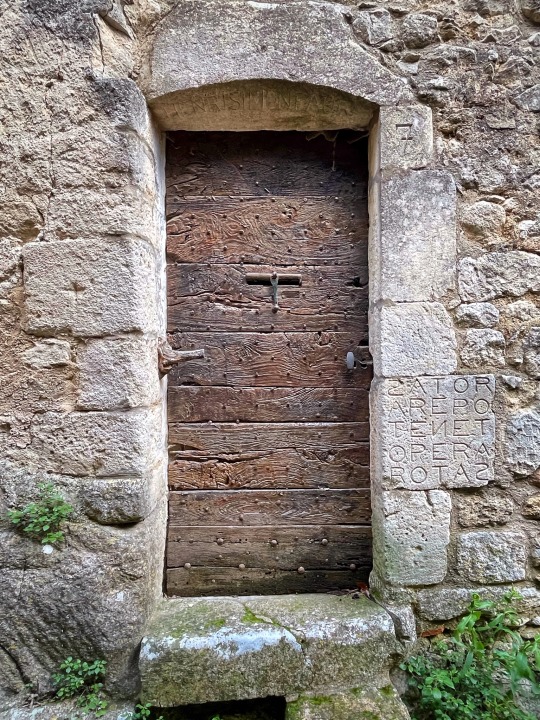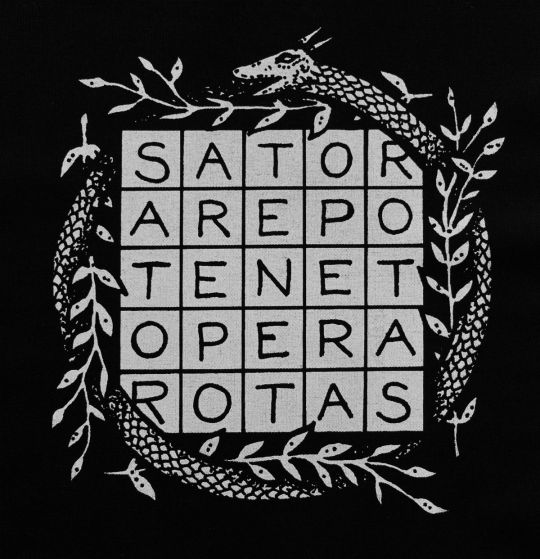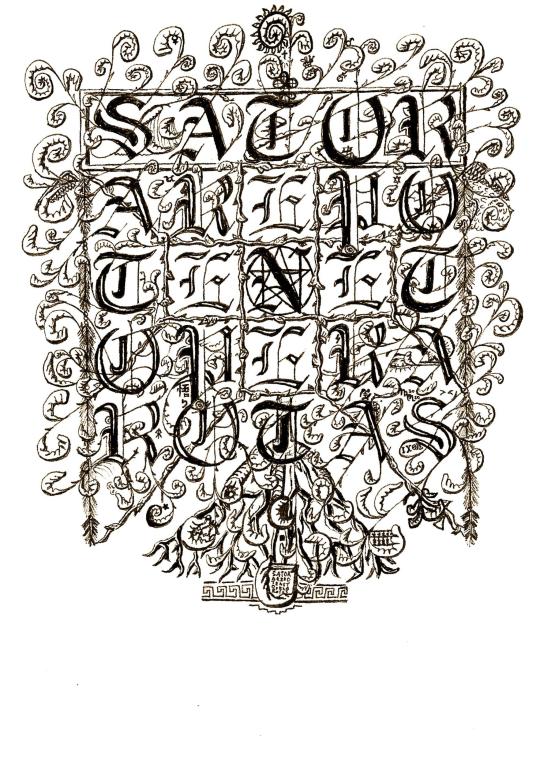#sator arepo tenet opera rotas
Explore tagged Tumblr posts
Text
"The God of Arepo" is a very good story, but I'm a bit angry that he is never mentioned to work with wheels
5 notes
·
View notes
Text
i haven't even seen Tenet. i'm just a big fan of the sator square
#psygullisms#sator arepo tenet opera rotas bitch#i've had an interest in palindromes since i was a kid
6 notes
·
View notes
Text


Klaus Behr
Sator, Arepo, Tenet, Opera, Rotas, 1983
https://www.mutualart.com/Artwork/Sator--Arepo--Tenet--Opera--Rotas/A28A2AE67E49B918
1 note
·
View note
Text

A 16th century German 'oath skull' (a human skull on which defendants swore their oath in Vehmic courts) engraved with the 'magical' Roman 'Sator square', mysterious palindromic word-squares found across the Roman world, comprising the words SATOR, AREPO, TENET, OPERA, ROTAS
Blog: https://thetravelbible.com/museum-of-artifacts/
5K notes
·
View notes
Text
Simple but Potent Traditional Banishing Spell
It is the holiday season and a time of parties. If you have had a visitor whose energy was toxic, this is how you can cleanse your house of their footprint and make sure they never come back.
With a handful of sea salt in your dominant hand, open your front door with your other hand.
Then speak the person's full name with contempt, as you throw the salt outside the door as if it's the ashes of someone you despise.
Close the door and lock it, chanting once, "Sator Arepo Tenet Opera Rotas".
Do not sweep away the salt. Let the wind, rain or snow take care of it. Wait until most of it is gone before cleaning your porch.
The spell is done and so is that little bitch.
255 notes
·
View notes
Text
instagram
-----
Sator è la prima parola dell’omonimo palindromo, costituito dalle cinque parole “SATOR - AREPO - TENET - OPERA – ROTAS”, ritrovato sia in forma di quadrato che in forma radiale o circolare su molti reperti archeologiciin Europa e in Italia, le cui prime tracce risalgono a oltre 2.000 anni fa.
Essendo formato da parole di 5 lettere ciascuna, è possibile scrivere la frase entro un quadrato di 25 caselle, che rimane leggibile dall'alto, dal basso, da destra e da sinistra.
L’enigma del quadrato di Sator è stato oggetto di molteplici interpretazioni, tuttavia ancora oggi alcuni ritengono che esso custodisca un significato nascosto. Proprio la molteplicità dei luoghi e dei testi in cui ritorna ne hanno resa particolarmente controversa l’interpretazione, soprattutto perché il termine AREPO, in esso contenuto, risulterebbe non strettamente di origine latina, e indicherebbe probabilmente un tipo di carro in uso presso le popolazioni galliche.
Difficile quindi stabilire il significato letterale della frase. Ad esempio, se si leggesse il palindromo da sinistra verso destra, si otterrebbe la frase “SATOR AREPO TENET OPERA ROTAS”, che secondo una prima interpretazione potrebbe tradursi con: “Il seminatore, col suo carro, tiene con cura le ruote”.
Una interpretazione più recente, vedrebbe nel palindromo un significato astronomico o cosmologico, e pertanto la traduzione sarebbe “il Creatore con il carro tiene in moto le orbite”. Tale interpretazione risulterebbe coerente con il modello di universo accettato nel basso Medioevo, che identificherebbe con la figura del Sator-Creatore il motore ultimo dell’universo.
P.S. Se prestate attenzione si forma una croce con la parola TENET
75 notes
·
View notes
Text


Les ruelles d’Oppède-le-Vieux renferment les traces d’un passé bien mystérieux, l’un d’entre eux : le Carré Magique, appelé également Carré Sator. Le carré SATOR est le plus ancien carré de lettres connu. Il est constitué des cinq mots latins SATOR (laboureur), AREPO (charrue), TENET (tenir en son pouvoir), OPERA (travail), et ROTAS (roues, orbite). Ces mots sont entrelacés en forment un palindrome. C’est à dire qu’il peut être lu à l’endroit, à l’envers, de haut-en-bas, et de bas-en-haut.
The streets of Oppède-le-Vieux contain traces of a very mysterious past, one of them: the Carré Magique, also called Carré Sator. The SATOR square is the oldest known square of letters. It consists of the five Latin words SATOR (plower), AREPO (plough), TENET (hold in its power), OPERA (work), and ROTAS (wheels, orbit). These words are intertwined and form a palindrome. That is, it can be read upside down, upside down, and down.
#photography#original photography#original photography on tumblr#provence#luberon#oppède-le-vieux#palindrome
78 notes
·
View notes
Text


Sator Square by Adrienne Rozzi
The Sator Square (or Rotas Square)
SATOR (from serere=to sow) Sower, planter; founder, progenitor (usually divine); originator
AREPO unknown, likely a proper name, either invented or, perhaps, of Egyptian origin
TENET (from tenere=to hold) holds, keeps; comprehends; possesses; masters; preserves
OPERA (noun) work, care; aid, service, effort/trouble; (from opus): works, deeds.
ROTAS (accusative plural of rota) wheels
The Sator Square is an ancient Roman 2D palindrome square made up of five Latin words. The oldest discovery of the square comes from the ruins of Pompeii in Herculaneum, a city buried in ash during the eruption of Mt. Vesuvius. The square’s translation is continuously debated but implies themes of a farmer plowing his field and the continuous maintenance of working the land. Consisting of five interconnected words, the Sator Square is often used as a protective talisman, believing evil spirits will get caught in the repetitive cycle of the square and lose their ability to harm those under the square’s protection. For this reason, the Sator Square has been found in Medieval churches, Renaissance grimoires, and it pops up quite a bit in folk magic practices.
John George Hohman utilizes the square in his famous grimoire, The Long Lost Friend, as a spell to “extinguish fire without water.” Furthermore, the Sator Square has been used to remove jinxes and fevers, as well as aid in safe travels when worn on your person. It is often placed above doorways and inscribed on objects for protection in the home and to ward against evil occurrences. The most fascinating aspect of the Sator Square, however, is found in it’s numerological breakdown. Each word in the talisman, whether in a row or column, can be reduced to the number 1. Many numerologists maintain that this repetition and coherence gives the Sator Square even more extraordinary powers.
53 notes
·
View notes
Text
Une porte dans la vieux Grenoble porte le mystérieux carré Sator connu depuis l’Antiquité romaine !
Le carré magique contenant le palindrome latin
SATOR AREPO TENET OPERA ROTAS
qui est un palindrome : on peut le lire en tout sens de gauche à droite et de droite à gauche de haut en bas et de bas en haut.
Sa traduction est encore controversée et donne une phrase énigmatique.
le semeur tient les roues — opera : par son travail, son œuvre.
Le carré Sator était souvent utilisé comme porte-bonheur au Moyen-Âge. Au cours des siècles suivants, il fut adopté comme protection contre les incendies.

#brittany#breizh#bretagne#middle age#moyenâge#antics#antique#antiquities#antiquité#savoy#savoie#grenoble#isère#dauphin#dauphinoise
8 notes
·
View notes
Text
Vetinari stares at the square. Well, hasn’t everything become singularly childish? Rotas squares – he has seen one of these since boyhood. When the likes of – ha! – Downey would attempt to summon entities during exam season to help with his Klatchian or ancient Morporkian lessons. Because the boy would rather summon unknown forces than study. The symbol in the middle of this particular square is a divergence from what he recalls Downey and Ludo attempting. They would following the traditional pattern: Rotas, Opera, Tenet, Arepo, Sator. The four words written out, each on a new line, to form a square. The nature of the mechanism, and how it was supposed to achieve their end goal, was never entirely clear to Vetinari. But, then, their childish attempts at conjuration preternatural aides never did result in anything much. In fact, it resulted in nothing at all, so far as Vetinari was aware and he would sometimes be sequestered in a high-back chair in the student lounge at one in the morning when such nonsense was attempted.
We all know Downey, as a boy, would pull shit like summoning Feared Lord Aethelrap the UnGodly Harbinger of Death rather than actually doing the homework himself.
Downey: Here is my homework. Done on time, sir, you will note.
Dr. Tindel: And smelling ominously of sulphor.
Downey: . ... ,,
Dr. Tindel: I'm going to have to make it a class rule that you cannot cheat by summoning entities from the abyss to do your homework for you, aren't I?
Downey: It was just a bit of fun, sir.
Dr. Tindel: Well. Did you at least return the entity to the abyss once you were done?
Downey: Yes, sir.
Dr. Tindel: And close out the portal properly?
Downey: Um. I think so, sir.
Cue screams from down the hall.
11 notes
·
View notes
Note
Hi there and new year blessings to you!
Please, if possible, could I ask for a spell in light. One to protect me and ward away any outside influence that is bringing me bad luck? A return to sender if you will or to just block anythinf bad?
My health has suddenly gotten quite bad. My 5 partner broke up with me out of the blue, even he said he can't explain it and that it's out of the blue for him too as we were talking about marraige right up until the last minuite.
I had a dream last night saying to protect myself and that someone is sending all of this to me, so I would appreciate it beyond belief.
Many thanks in advance. 🍃🖤
Easiest way is to make a witch bottle.
How to:
Within a bottle place nails, pins, thorns, some agrimony, parsley, salt, rowan berries, hellebore flowers, and yarrow.
Add to it a drop of your blood, some of your hair and fingernail clippings, and fill it up with your piss.
Cork it and put it into a raging fire (outdoors obviously) with the words:
“Sator arepo tenet opera rotas”
Then stand at a safe distance from the fire and watch for results.
If the contents boil the spell on you will break and you must take it and bury it upside down in a cemetery or at a crossroads.
If the bottle breaks instead, the spell is too great and other work must be done to destroy the influence.
#folk witchcraft#traditional witchcraft#folk witches#traditional witches#witchcraft#witch#folk witch#trad witch#witch bottle#hex breaking#uncrossing#spellwork#spells#folk magic
7 notes
·
View notes
Text
alador meaning HUD?
I tried to dig deeper into each of the blight family members' names. I learned that amity: meaning diplomacy and friendship emira: meaning princess. edric: meaning ruler and prosperity. odalia: worshiper of god or maid.
But why Alador's name, it is just considered a name that evokes confidence and luck and has no specific meaning, even considering whether it is suitable for the blight family, is a bit strange. So I dug deeper into the meaning of the name Alador and found out that alador in Ethiopia also literally means the right nail and is the nail that crucified Jesus. We know that crucifixion was a painful and brutal death sentence for the victims who were publicly executed, does this imply that Alador's underlying personality is brutal, violent and unforgiving or does it imply that Alador's rebirth and desire for redemption at the end of COTH, plus one of the things that amity thought was cool about Alador was joining the bones bawl underground fighting tournament, it also implies that Alador loves fighting. Does this imply anything about Alador's nature since the names in the owl house often hint at the characters' personalities and fates and I wonder if it has anything to do with the religious themes in the show? (Here is a quote about the name Alador that I found: The Coptic Prayer of the Virgin in Bartos describes how that Christ was crucified with five nails, which were named Sator, Arepo, Tenet, Opera and Rotas. This reading of the words accordingly entered the Ethiopic tradition where they became the names of the wounds of Christ. In Ethiopian tradition the words are slightly altered, with SADOR being the lance wound, ALADOR being the right-hand wound, DANAT being the left-hand wound, ADERA being the right foot wound, and RODAS being the left foot wound. These 5 words are prayed on each knot of a 41 count Ethiopian mequetaria (prayer rope).)
9 notes
·
View notes
Text

Fidderford Mcgucket ele/dele
Vocês viram FIDDERFORD MCGUCKET, de GRAVITY FALLS, pelas ruas da cidade? Nem me lembrava que se parecia tanto com JOHN TORTURRO no auge de seus CINQUENTA E CINCO anos. Apesar de ser natural de BLACKVAIL, pode ser encontrado em VERIDIAN agora, trabalhando como ARTESÃO E DONO DE UMA LOJA DE BRINQUEDOS. Dizem que ele é INSTÁVEL E FROUXO, o que não exclui o fato de também ser GENIAL E SONHADOR.
Background
A última memória de Fidderford foi turva, se viu acordando em um pequeno barco de madeira, estava à deriva de um lago amplo das densas florestas de Blackvail. Apenas isso. O que era estranho, um homem velho como ele parecia ter vivido muito, julgando pelas olheiras e a aliança em seu bolso.
Porém, as poucas coisas que estavam em sua mente trouxeram a ele um plano. Um imóvel antigo da própria família, em Veridian, que talvez fosse o local que estava procurando antes mesmo de entrar na água. Mcgucket's Ark.

Quando seus dias se tornarem insípidos e rasos, enquanto a eternidade lhe descer a garganta. SATOR. Não saberá dizer quantos se passaram, dias, semanas, horas, chapéus, ou minutos, não se lembrará do começo, e por isso, não poderá ter o luxo do fim.
A quebra da mente é um termo muito simplista, para aquele que perdeu todo seu senso critico. Despido de todo os sentidos, mas com todos eles misturados ao mesmo tempo AREPO.
A dor é a materialização da vida, estou vivo então sinto essa dor, sinto dor por estar vivo. TENET. Mas esse sofrimento está sendo mutilado enquanto o mesmo corrói as dobras do meu cérebro. Não se espante por eu não saber me portar, uma colher de sopa de mel e dois litros de água.
Algumas vezes lembro que comprei uma casa e tive um filho, mas nas outras vezes eu sinto o universo mordendo meus olhos. Foi antes ou depois da infância? Com quem eu casei? OPERA.
Nunca foi sobre minha felicidade, pouco mesmo minha vida, vai além do universo. A tragédia é sobre como meu eu aprendeu que saber tudo tem um preço, assim como querer esquecer. ROTAS. Esqueçam a dor e esqueceram o prazer, esqueçam dor e esqueceram tudo, esqueçam a dor e se lembrem de Sator.
5 notes
·
View notes
Text
3
An ancient civilization created a writing system that can be read in two directions, as glyphs are paired in mirrored doubles (like "b" vs "d").
To unlock the door, one must arrange fairly heavy stone blocks with letters on them in a 5x5 grid, with one stone missing on purpose for the movement to be possible. The last letter is known.
Fun twist could be to make the text on the grid similar to SATOR AREPO TENET OPERA ROTAS - Readable in any direction when put in a 5x5 grid.
6 notes
·
View notes
Text

16th century German 'oath skull' (a human skull on which defendants swore their oath in Vehmic courts) engraved with the 'magical' Roman 'Sator square', mysterious palindromic word-squares found across the Roman world, comprising the words SATOR, AREPO, TENET, OPERA, ROTAS
2 notes
·
View notes
Text

The Oath Skull and the Sator Square: A Haunting Relic of Justice and Mystery
Imagine standing trial in a dimly lit 16th-century German Vehmic court, where justice was as secretive as it was severe. Before you sits a human skull—not just any skull, but one etched with ancient power. This is an "oath skull", upon which defendants would swear their innocence or truth, binding themselves not only to law but to something far older, and perhaps more arcane.
Carved into its surface is the Sator Square, a mysterious Latin palindrome that reads the same backward, forward, and vertically:
SATOR
AREPO
TENET
OPERA
ROTAS
This word square has been unearthed across the ancient Roman world—from Pompeii to Britain—and is often linked to ritual, magic, and divine protection. Its precise meaning remains elusive, fueling centuries of speculation.
On this skull, however, the square becomes something more than cryptic: it becomes a sacred seal, perhaps believed to ensure that the truth would prevail—or that divine retribution would strike the perjurer.
Part legal instrument, part occult object, the oath skull stands as a chilling symbol of how law, fear, and mysticism once intertwined in the shadowy corners of medieval Europe.
Source: Ancient History
Facebook
3 notes
·
View notes